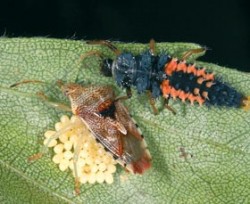V živočišné říši nalezneme rozličné způsoby chování, které zajišťují a zvyšují šanci potomků na přežití, což zaručuje přenos a působnost genotypu rodičů v dalších generacích. Nejčastější formou je přímá péče o vajíčka a mláďata. Rodičovská péče je zajímavý evoluční fenomén, jehož různé projevy můžeme pozorovat u mnoha skupin bezobratlých živočichů i obratlovců. V tomto článku si přiblížíme naše zástupce ploštic rodu Elasmucha, které patří mezi běžné druhy a vyznačují se zajímavou mateřskou péčí. Uvedené výsledky vycházejí z publikovaných literárních pramenů a našich vlastních víceletých pozorování v přírodě i v insektáriích.
Hlavní použitá literatura:
Duda L. (1879): Zvláštní úkaz mateřské péče u hmyzu. Vesmír 8 (2): 15–16
Hanel L., Hanelová J. (2006): Chováme knězovité ploštice. Akva tera fórum 8: 60–65
Hanel L., Hanelová J. (2008): Co víme o biologii kněze velkého. Živa 1: 30–31
Jordan K. H. C. (1958): Die Biologie von Elasmucha grisea L. – Beiträge zur Entomologie 8, 3, 4: 385–397
Kaitala A., Mappes J. (1997): Parental care and reproductive investment in shield bugs (Acanthosomatidae, Heteroptera). Oikos 80 (1): 3–7
Mappes J. (1994): Parasites and female ability to defend offspring in the parent bug Elasmu-cha grisea L. Ethology 97: 76-80
Melber A., Hölscher L., Schmidt G. H. (1980): Further Studies on the Social Behaviour and its Ecological Significance in Elasmucha grisea L. (Hem.-Het.:
Acanthosomatidae). Zool. Anz. 1/2: 27–38
Melber A., Klindworth H.-G., Schmidt G. H. (1981): Saisonaler Wirtpflanzenwechsel bei der baumbewohnenden Wanze Elasmucha grisea L. (Heteroptera:
Acanthosomatidae). Z. ang. Ent. 91: 55–62
Melber A., Schmidt G. H. (1975a): Sozialverhalten zweier Elasmucha-Arten (Heteroptera: Insecta). Z. Tierpsychol. 39: 403–414
Melber A., Schmidt G. H. (1975b): Ökologische Bedeutung des Sozialverhaltens zweier Elasmucha-Arten (Heteroptera: Insekta). Oecologia (Berl) 18: 121–128
Roth S., Adaschkiewitz W., Fischer Ch. (2006): Notes on the bionomics of Elasmucha grisea (Linnaeus 1758) (Heteroptera, Acanthosomatidae) with special regard to joint brood guarding, 1153- 1167. In: Hug the Bug. For Love of true Bugs. Festschrift zum 70. Geburtstag von Ernst Heiss. Wissenschaftliche Redaktion: W. Rabitsch 1184 pp.
Strawinski K. (1951): Introductory studies on the biology of Elasmucha ferrugata F. (Hem.-Heteroptera). Ann. Univ. Marie Curie Sklod. Lublin (C) 4: 149–163
This article describes the maternal care of the Parent Bug Elasmucha grisea (main host plants: birch tree or alder), Blueberry Shield Bug Elasmucha ferrugata (main host plant: heathberry) and the Spotted Breeding Bug Elasmucha fieberi (main host plant: birch tree) from the family Prick Bugs (Acanthosomatidae). Females straddle their eggs and young nymphs whilst showing specific defensive behaviour against various invertebrate predators. Defensive behaviour of the female includes body movements such as rotation, tilting, wing fanning and attacking, which may be physiologically costly. Literature sources and our experiments in an insectarium show, in some cases, that there is a possibility of the Parent Bug offspring surviving without maternal care. The Parent Bug female straddles her eggs until they develop to the 3rd instar; in the case of the Blueberry Shield Bug and the Spotted Breeding Bug to the 2nd instar. The females of this species accompany their offspring in their first instars on the food search. In the insectarium under laboratory conditions we observed that the Parent Bug and Blueberry Shield Bug had successfully adopted an alien clutch of their own species. Reciprocal successful adoptions of clutches between females of the Parent Bug and the Spotted Breeding Bug are possible. It is evident that these species are very efficient and often used for various ethological experiments and observations. This allows teachers on their field trips with pupils and students to easily demonstrate an interesting example of parental care in the insect kingdom.
 Samička kněze mateřského se natáčí proti nebezpečí, zde proti larvě slunéčka východního (Harmonia axyridis)
Foto L. Hanel / © Photo L. Hanel
Samička kněze mateřského se natáčí proti nebezpečí, zde proti larvě slunéčka východního (Harmonia axyridis)
Foto L. Hanel / © Photo L. Hanel



